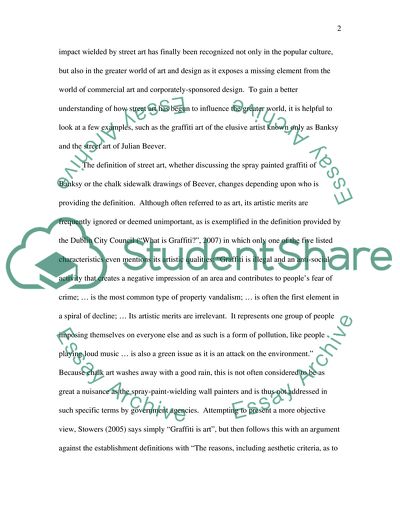Cite this document
(“Street Art is a style and an influence Essay Example | Topics and Well Written Essays - 2500 words”, n.d.)
Street Art is a style and an influence Essay Example | Topics and Well Written Essays - 2500 words. Retrieved from https://studentshare.org/visual-arts-film-studies/1540632-street-art-is-a-style-and-an-influence-discuss-its-impact-within-art-and-design-with-examples-of-at-least-two-artistsgrafitti-and-julian-beever
Street Art is a style and an influence Essay Example | Topics and Well Written Essays - 2500 words. Retrieved from https://studentshare.org/visual-arts-film-studies/1540632-street-art-is-a-style-and-an-influence-discuss-its-impact-within-art-and-design-with-examples-of-at-least-two-artistsgrafitti-and-julian-beever
(Street Art Is a Style and an Influence Essay Example | Topics and Well Written Essays - 2500 Words)
Street Art Is a Style and an Influence Essay Example | Topics and Well Written Essays - 2500 Words. https://studentshare.org/visual-arts-film-studies/1540632-street-art-is-a-style-and-an-influence-discuss-its-impact-within-art-and-design-with-examples-of-at-least-two-artistsgrafitti-and-julian-beever.
Street Art Is a Style and an Influence Essay Example | Topics and Well Written Essays - 2500 Words. https://studentshare.org/visual-arts-film-studies/1540632-street-art-is-a-style-and-an-influence-discuss-its-impact-within-art-and-design-with-examples-of-at-least-two-artistsgrafitti-and-julian-beever.
“Street Art Is a Style and an Influence Essay Example | Topics and Well Written Essays - 2500 Words”, n.d. https://studentshare.org/visual-arts-film-studies/1540632-street-art-is-a-style-and-an-influence-discuss-its-impact-within-art-and-design-with-examples-of-at-least-two-artistsgrafitti-and-julian-beever.


